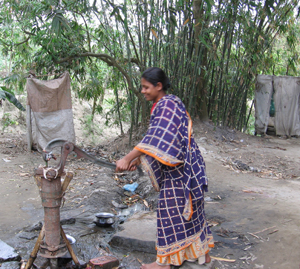
 |
|---|
Bangladeshi woman pumping a typical tube well. Two latrines, potential sources of microbial contamination, can be seen draped in the background. |
This study set out to test the microbiological quality of tube well water pumped from shallow aquifers in two rural villages in Bangladesh. Though the potential for groundwater contamination by microbial pathogens is high, due to poor sanitation and intensive pumping, there is little previous data countrywide. Sampling occurred at the end of both the wet and dry season. E.coli, a standard fecal indicator, was measured in each well sampled, and the 16s rRNA gene of Bacteroides sp., a molecular fecal marker, was quantified in a subset of wells. Water quality was contrasted in two hydrogeological settings: fine sediments cap the aquifer and slow groundwater recharge in one village (Site B), while coarse sands extend to the surface, allowing a faster relative recharge rate at the other (Site C) (Stute et al, in press 2007, Aziz et al, in review).
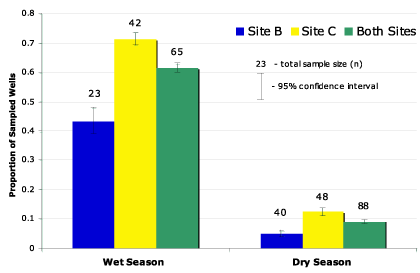 |
|---|
This bar graph shows the proportion of sampled wells that contained E.coli, an indicator of fecal contamination, during each season and in each village. |
Overall, 40% of the 95 wells sampled were positive for E.coli during one of the sampling periods. The Bacteroides data confirmed the presence of fecal contamination in nearly all wells, and showed potential to act as a marker of the source of contaminated water. A higher proportion of wells were contaminated by E.coli in wet season (61%) than during the dry season (9%). Season was the strongest factor determining whether a well contained E.coli, but village was another. During the wet season, the Site C village contained a higher proportion of E.coli contaminated wells than Site B. The village comparison incorporates linked differences between sediment type, recharge rate, well depth, and dissolved arsenic concentration in the two villages. The data indicate that tube well water is vastly preferable to surface water from the standpoint of microbial pathogens; however, tube well water may not be absolutely safe. Spatial and temporal variability in a well’s vulnerability to microbial contamination should be considered.
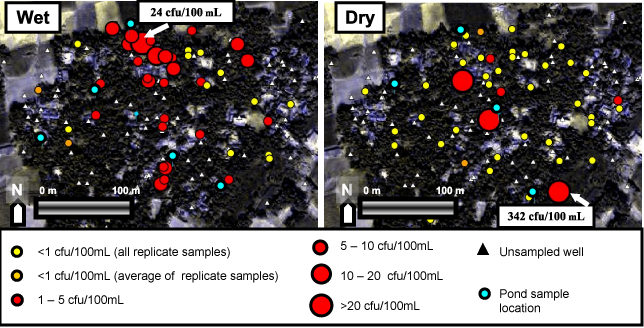 |
|---|
This map shows the concentration of E.coli at individual wells sampled in one village, Site C, during the wet season and during the dry season. E.coli is measured in units called colony forming units (cfu)/100 mL. There are more contaminated wells, at higher concentrations, during the wet season. The background image is an IKONOS satellite photo. The dark areas show the village tree cover, which is surrounded by agricultural fields. The purple color indicates the presence of water in ponds or fields. |
In the time that Jessica spent doing fieldwork in Bangladesh , March 2007, she enjoyed the opportunity to meet local famlies and community members.
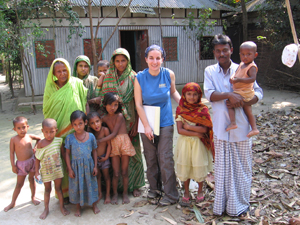 |
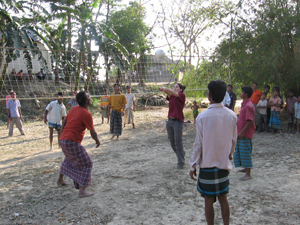 |
|---|---|
Jessica with a family in Baylakandi (Site B) during the March 2007 trip (dry season). |
Jessica takes a break from sampling wells to play volleyball with some villagers in Baylakandi (Site B) during the March 2007 trip. |